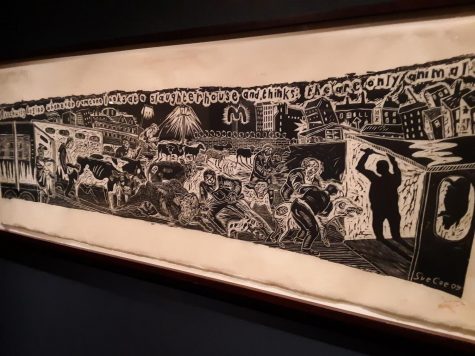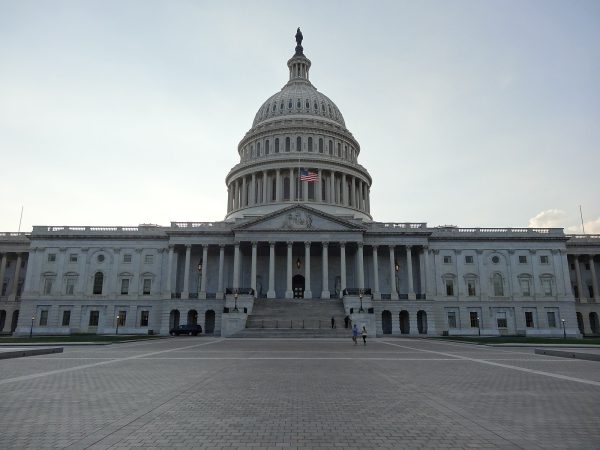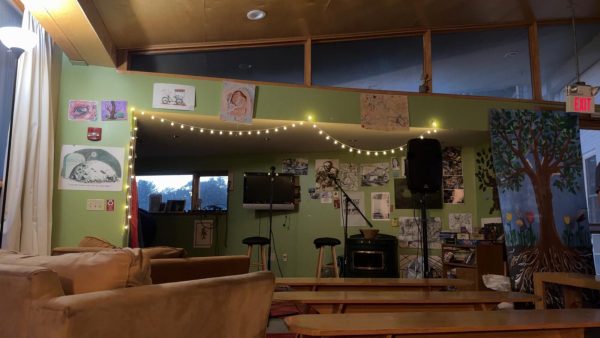Panel to Discuss Claims of Anti-Semitism of Trout Gallery-Featured Artist
The panel discussion, “Sue Coe’s Appropriation of Holocaust Imagery: An Evening of Shared Inquiry,” will be held in the Weiss Center for the Arts, room 235, at 7 p.m. on Wednesday, April 3.

The Trout Gallery will hold a panel discussion Wednesday night on one of the gallery’s featured artist’s “appropriation of Holocaust Imagery,” an event prompted by student backlash to the paintings.
Sue Coe’s paintings use Holocaust imagery to depict animal suffering at the slaughterhouse, and three of her paintings are displayed in the Trout Gallery as part of an exhibition, “Agency, Tolerance, and Imagination,” about art and civic engagement.
“There were a number of questions and inquiries regarding Sue Coe’s work, and on the basis of those… it became clear that some further discussion would be helpful,” said Phillip Earenfight, director of the Trout Gallery and associate professor of Art and Art History.
The event, “Sue Coe’s Appropriation of Holocaust Imagery: An Evening of Shared Inquiry,” will be held in the Weiss Center for the Arts, room 235, at 7 p.m. on Wednesday, April 3.
Coe’s paintings received backlash from some students for equating the experience of Jewish people during the Holocaust to animals led to slaughter. Mia Merrill ’19 wrote a March 28 article for heyalma.com titled “My College Called it a ‘Controversial’ Art Show. I Called it Anti-Semitic.”
“The art… was shocking,” Merrill wrote, “The artist wanted to convince viewers to give up meat by directly comparing the animal industry to the Holocaust, complete with Nazi propaganda posters and scenes of non-kosher slaughter at Auschwitz.”
Coe’s paintings are owned by the gallery, said Earenfight, and were purchased in 2014 with funds from donations and membership fees to the Trout Gallery. Coe’s work has been shown in the Hirshhorn Museum in Washington, D.C. and in the New York Times, the New Yorker, Rolling Stone and other publications.
Coe came to Dickinson in 2013 to accept the Arts Award from the Department of Art and Art History and to fulfill a residency. A full exhibition of her works, which included the three paintings on display now, was held in the Trout Gallery from November 2013 to February 2014.
“The show itself was well-received,” said Earenfight, and that “criticisms of [Coe’s] work never reached our desk,” at the Trout Gallery.
“It appears now years after the fact there was some discussion in various classes that there were some people that found… her use of the appropriation of various styles from the Nazi area problematic.”
Of the current display of Coe’s paintings, “There was no warning for what we were about to see, and [the exhibition] lacked any nuanced discussion of how Jewish scholars have grappled with this metaphor in the 20th century,” wrote Merrill in her article.
“When it came to organize this show, we did not have any record of any responses adversely to [Coe’s] work, but we certainly knew that her work is challenging,” said Earenfight, “there’s no question, and she knows she’s working in particularly challenging areas by appropriating imagery.”
Andrea Lieber, professor of religion and Sophia Ava Asbell Chair in Judaic Studies, will serve on the panel for the event. Lieber said “I think right now the students’ response and even the gallery’s lack of foresight in needing to contextualize the exhibition better is something we need to pay attention to.”

Lieber said that students are reacting to Coe’s work “in this moment when the Jewish community is highly sensitive to anti-Semitism because of the Pittsburgh Synagogue massacre… cemeteries being vandalized… [and] a perception of a rise in anti-Semitism more broadly.”
“The world’s different now,” said Earenfight, “The same objects can have one resonance at one time and at a different time a different resonance. I would say that the nature of the climate nationally is such that it doesn’t surprise me that there are questions now that weren’t necessarily raised to the level that they are now… when the show was first shown.”
“I am glad that [The Asbell Center for Jewish Life] and the Trout are partnering to hold this program, especially because there have been multiple instances of artists using Holocaust imagery to advance their own agenda,” said Mychal Herber ’19 before the event.
“I do want to underscore the idea that museums serve a variety of roles,” said Earenfight, “but in this particular capacity on Wednesday night it will be a forum where issues are raised and the objects that are on display provide a point of discussion.”
The event is co-sponsored by the Asbell Center and the Trout Gallery. Earenfight, Lieber, Assistant Professor of Philosophy and Director of Ethics Across Campus & the Curriculum Amy McKiernan, and Associate Professor of Music Amy Wlodarski will speak on the panel. Gary Kirk, the executive director of the Center for Civic Learning & Action, will moderate the event.




